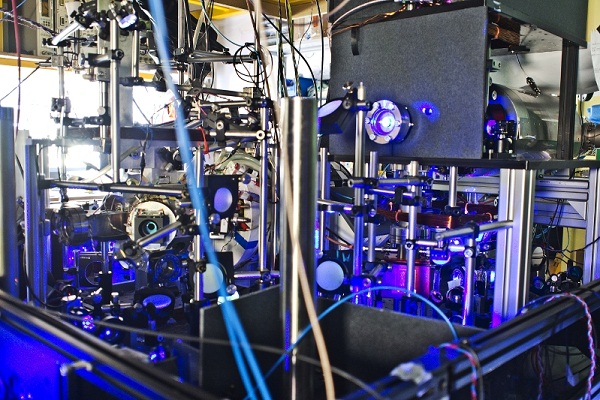In the past few years, optical atomic clocks have made spectacular progress. They have become 100 times more precise than the best cesium clocks, and their frequency can be controlled up to the 18th digit. Unfortunately, this precision has, to date, been available only locally since conventional satellite transmission cannot provide such a high resolution.
This has recently changed thanks to a new direct connection between France and Germany : high-precision frequencies can now "travel" through a 1400 km optical fiber link between the Physikalisch-Technische Bundesanstalt (PTB) in Braunschweig, Germany, and LNE-SYRTE (Systèmes de Référence Temps-Espace) in Paris, France. The first comparison realized between the French and German optical strontium clocks proved that the clocks tick at the same frequency with a relative uncertainty of 5 × 10-17, although they were developed in two independent institutes with different experimental set-up and environment.

This result is far from being reachable with other comparison means than optical links, which provided here a resolution of 3x10-19. This work is published in the current edition of Nature Communications. In the future, such optical fiber links could build a whole network of optical clocks which could be compared with each other within minutes, with benefits in fundamental physics, astronomy and geoscience.
The experimental set-up for the clocks comparison is shown on Figure below. The strontium clocks are built with cold atoms in an optical lattice. They rely on light in the visible spectral range which can be measured very precisely, thanks to its high frequency and optical frequency combs - a technology award by the Nobel prize of Physics in 2005-. The 1400 km long link is based on standard telecom optical fibers for which we compensate power losses of 20 orders of magnitude by means of special amplifiers. We also actively suppress frequency fluctuations added by the propagation by up to 6 orders of magnitude, enabling the transmission of optical signals with very high stability.

Approximately midway, the signals from LNE-SYRTE and PTB meet at the University of Strasbourg, so that the clocks of the two institutes can be compared there. The German part of the link uses commercially rented optical fiber and facilities of the German National Research and Education Network (DFN). The French part of the link is operated by the French Ministry of Education and Research within the framework of the RENATER network and was developed jointly by Laboratoire de Physique des Lasers (LPL) and LNE-SYRTE.
Comparing optical clocks at the highest resolution opens the way to a wide range of very sensitive physical experiments. For instance, the rate of a clock slightly depends on the local gravitational potential : comparing two clocks yields the height difference between them – by measuring the gravitational redshift – thus providing data points for the geodetic reference surface, the so-called "geoid". This work also clears the path towards a redefinition of the unit of time, the SI second, through regular and practical international comparisons of optical clocks.
This successful collaboration is a first step towards a European network of optical clocks which could provide ultrastable high-precision optical reference signals to the most diverse users. Various research areas will benefit from this – fundamental research (to test the fundamental laws of physics), astrophysics (to improve synchronization between telescopes), geoscience and, last but not least, metrology.
Besides PTB, LNE-SYRTE (CNRS/Observatoire de Paris/Laboratoire National d’Essais/University Paris 6/PSL Research University and Sorbonne) and LPL (CNRS/University Paris 13 Sorbonne Paris Cité), the following partners are involved : RENATER, LP2N (Institut d’Optique Graduate School, CNRS, and Université de Bordeaux) and Institut für Erdmessung (Leibniz Universität Hannover).
We acknowledge funding support from the Agence Nationale de la Recherche (ANR blanc, Labex First-TF, Equipex REFIMEVE+), the European Metrology Research Programme (contract NEAT-FT and ITOC), Centre National d’Études Spatiales (CNES), Conseil Régional Île-de-France (DIM Nano’K), CNRS with Action Spécifique Gravitation, Références, Astronomie, Métrologie (GRAM) and the German Research Foundation DFG within RTG 1729 and CRC 1128 geo-Q. Research at PTB was supported by the Centre of Quantum Engineering and Space-Time Research (QUEST).
